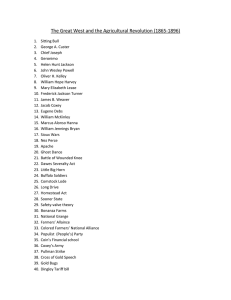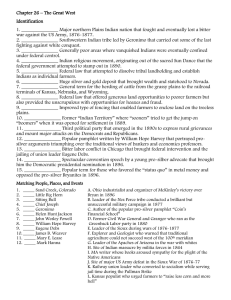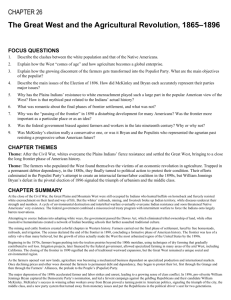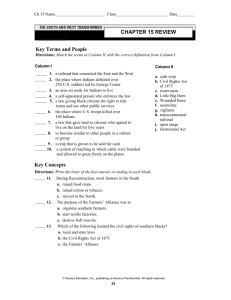The Great West and the Agricultural Revolution, –1896 1865 CHAPTER 26
advertisement
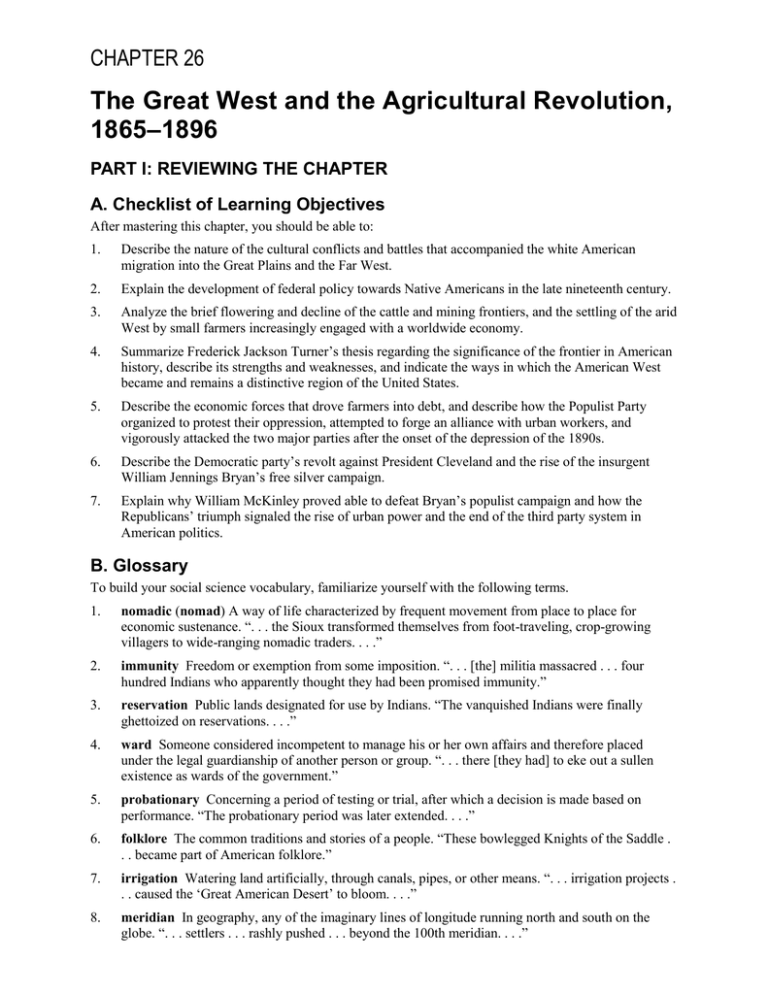
CHAPTER 26 The Great West and the Agricultural Revolution, 1865–1896 PART I: REVIEWING THE CHAPTER A. Checklist of Learning Objectives After mastering this chapter, you should be able to: 1. Describe the nature of the cultural conflicts and battles that accompanied the white American migration into the Great Plains and the Far West. 2. Explain the development of federal policy towards Native Americans in the late nineteenth century. 3. Analyze the brief flowering and decline of the cattle and mining frontiers, and the settling of the arid West by small farmers increasingly engaged with a worldwide economy. 4. Summarize Frederick Jackson Turner’s thesis regarding the significance of the frontier in American history, describe its strengths and weaknesses, and indicate the ways in which the American West became and remains a distinctive region of the United States. 5. Describe the economic forces that drove farmers into debt, and describe how the Populist Party organized to protest their oppression, attempted to forge an alliance with urban workers, and vigorously attacked the two major parties after the onset of the depression of the 1890s. 6. Describe the Democratic party’s revolt against President Cleveland and the rise of the insurgent William Jennings Bryan’s free silver campaign. 7. Explain why William McKinley proved able to defeat Bryan’s populist campaign and how the Republicans’ triumph signaled the rise of urban power and the end of the third party system in American politics. B. Glossary To build your social science vocabulary, familiarize yourself with the following terms. 1. nomadic (nomad) A way of life characterized by frequent movement from place to place for economic sustenance. “. . . the Sioux transformed themselves from foot-traveling, crop-growing villagers to wide-ranging nomadic traders. . . .” 2. immunity Freedom or exemption from some imposition. “. . . [the] militia massacred . . . four hundred Indians who apparently thought they had been promised immunity.” 3. reservation Public lands designated for use by Indians. “The vanquished Indians were finally ghettoized on reservations. . . .” 4. ward Someone considered incompetent to manage his or her own affairs and therefore placed under the legal guardianship of another person or group. “. . . there [they had] to eke out a sullen existence as wards of the government.” 5. probationary Concerning a period of testing or trial, after which a decision is made based on performance. “The probationary period was later extended. . . .” 6. folklore The common traditions and stories of a people. “These bowlegged Knights of the Saddle . . . became part of American folklore.” 7. irrigation Watering land artificially, through canals, pipes, or other means. “. . . irrigation projects . . . caused the ‘Great American Desert’ to bloom. . . .” 8. meridian In geography, any of the imaginary lines of longitude running north and south on the globe. “. . . settlers . . . rashly pushed . . . beyond the 100th meridian. . . .” 9. contiguous Joined together by common borders. “Only Oklahoma, New Mexico, and Arizona remained to be lifted into statehood from contiguous territory on the mainland of North America.” 10. safety valve Anything, such as the American frontier, that allegedly serves as a necessary outlet for built-up pressure, energy, and so on. “But the ‘safety-valve’ theory does have some validity.” 11. loan shark A person who lends money at an exorbitant or illegal rate of interest. “The [farmers] . . . cried out in despair against the loan sharks. . . .” 12. serfdom The feudal condition of being permanently bound to land owned by someone else. “. . . the farmers were about to sink into a status suggesting Old World serfdom.” 13. mumbo jumbo Mysterious and unintelligible words or behavior. “Kelley, a Mason, even found farmers receptive to his mumbo jumbo of passwords and secret rituals. . . .” 14. prophet A person believed to speak with divine power or special gifts, sometimes including predicting the future (hence any specially talented or eloquent advocate of a cause). “Numerous fiery prophets leapt forward to trumpet the Populist cause.” 15. citadel A fortress occupying a commanding height. “ . . . join hands with urban workers, and mount a successful attack on the northeastern citadels of power.” PART II: CHECKING YOUR PROGRESS A. True-False Where the statement is true, circle T; where it is false, circle F. 1. T F The acquisition of Spanish horses transformed the Sioux and Cheyenne from cropgrowing villagers into nomadic buffalo hunters. 2. T F The Plains Indians were rather quickly and easily defeated by the U.S. Army. 3. T F A crucial factor in defeating the Indians was the destruction of the buffalo, a vital source of food and other supplies. 4. T F Humanitarian reformers respected the Indians’ traditional culture and tried to preserve their tribal way of life. 5. T F Individual gold and silver miners proved unable to compete with large mining corporations and trained engineers. 6. T F During the peak years of the Long Drive, the cattlemen’s prosperity depended on driving large beef herds great distances to railroad terminal points. 7. T F The fair administration of the Homestead Act enabled many poorer farmers to achieve economic success on the plains of the arid, frontier West. 8. T F Although very few city dwellers ever migrated west to take up farming, the frontier “safety valve” did have some positive effects by luring some immigrants to the West and helping to keep urban wages higher than they otherwise might have been. 9. T F The farmers who settled the Great Plains were usually single-crop producers who became increasingly dependent on competitive and unstable world markets to sell their agricultural products. 10. T F Western and southern farmers were able to organize quickly and effectively to break their cycle of debt, falling prices, and exploitation by the railroads and other “middlemen.” 11. T F A fundamental problem of the Farmers’ Alliance in the South was their inability to overcome the racial division between poor white and black farmers. 12. T F The economic crisis of the 1890s strengthened the Populists’ belief that farmers and industrial workers should form an alliance against economic and political oppression. 13. T F Republican political manager Mark Hanna struggled to raise enough funds to combat William Jennings Bryan’s pro-silver campaign. 14. T F Bryan’s populist campaign failed partly because he was unable to persuade enough urban workers to join his essentially rural-based cause. 15. T F McKinley’s victory in 1896 ushered in an era marked by Republican domination, weakened party organization, and the fading of the money issue in American politics. B. Multiple Choice Select the best answer and circle the corresponding letter. 1. The Indians of the western plains offered strong resistance to white expansion through their effective use of a. artillery and infantry tactics. b. Canada and Mexico as safe havens from which to conduct warfare. c. nighttime and winter campaigning. d. eastern journalists and artists to publicize their cause. e. superb horsemanship and mobility. 2. The federal government’s attempt to confine Indians to certain areas through formal treaties was largely ineffective because a. the nomadic Plains Indians largely rejected the idea of formal authority and defined territory. b. Congress refused to ratify treaties signed with the Indians. c. the treaties made no effective provisions for enforcement. d. the largest tribe, the Sioux, refused to sign any treaties with the whites. e. the Indians repeatedly broke out of the proposed reservations and resumed open warfare. 3. The warfare that led up to the Battle of the Little Big Horn was set off by a. white intrusion into the previously reserved Indian territory of Oklahoma. b. Indian attacks on the transcontinental railroad construction crews. c. the Indians’ defeat and killing of Captain William Fetterman’s entire military unit in Montana. d. a conflict over the interpretation of the second Treaty of Fort Laramie. e. white intrusions into the Indians’ sacred Black Hills after the discovery of gold there. 4. Which of the following was not among the factors that finally led to the defeat of the Plains Indians and their confinement to reservations? a. The federal government’s willingness to deploy unrelenting military force b. The constant political infighting among the Sioux, Cheyenne, Arapaho, and Apache tribes c. The destruction of the buffalo upon which the Indian way of life depended d. The railroads’ intrusive penetration of Indian lands e. The Indians’ vulnerability to white people’s diseases and liquor 5. Many religious reformers, federal boarding schools, and the Dawes Act were all focused on the goal of a. enabling Indians to achieve economic opportunity on the reservations. b. assisting Indians who chose to migrate from the remote reservations to towns and cities. c. helping Indians form an effective pan-Indian alliance beyond their tribal identity. d. undermining Indians’ traditional culture and assimilating them into white American culture and society. e. weakening the Bureau of Indian Affairs’ monopoly on Indian policy. 6. Both the mining and cattle frontiers of the late nineteenth-century West saw a/an a. increase of ethnic and class conflict. b. loss of economic viability after an initial boom. c. turn from large-scale investment to the individual entrepreneur. d. brief flourishing of individual enterprise eventually followed by large corporate takeovers. e. influx of immigrant miners and cowboys from Europe. 7. The problem of sustaining agriculture in the arid West was solved most successfully through a. concentrating agriculture in the more fertile mountain valleys. b. the use of small-scale family farms rather than large bonanza farms. c. the use of irrigation from dammed western rivers. d. the turn to desert crops like olives and dates. e. revising the Homestead Act to give away free farms of 640 acres instead of the inadequate 160 acres. 8. The safety valve theory of the frontier claims that a. Americans were able to divert the most violent elements of the population to the West. b. the conflict between farmers and ranchers was relieved by the Homestead Act. c. class and labor conflict in America was alleviated because eastern workers could always migrate to the West and become independent farmers. d. political movements such as the Populists provided relief for the most serious grievances of western farmers. e. the wide-open spaces of the West provided an arena where Americans’ attachment to guns and violence could be pursued without threatening the social fabric. 9. Which one of these factors did not make the trans-Mississippi West a unique part of the American frontier experience? a. The large-scale engagement and struggle between white Anglo and Hispanic cultures. b. The problem of applying new technologies in a hostile wilderness c. The scale and severity of environmental challenges in an arid environment d. The large role of the federal government in economic and social development e. The final military defeat of American Indians and their continuing substantial presence in the region. 10. By the 1880s, most western farmers faced hard times because a. free land was no longer available under the Homestead Act. b. they were unable to increase grain production to keep up with demand. c. they were being strangled by excessive federal regulation of agriculture. d. they resisted the adoption of technologically improved farming techniques. e. they were forced to sell their grain at declining prices in volatile and depressed world markets. 11. Which of the following was not among the political goals of the Populist party in the 1890s? a. Nationalizing the railroad, telegraph, and telephone b. Creation of a national system of unemployment insurance and old-age pensions c. A graduated income tax d. Free and unlimited coinage of silver money e. Federally-owned warehouses where farmers could store their grain until prices rose. 12. The federal government’s use of the U.S. Army to crush the Pullman strike in Chicago aroused great anger from both organized labor and the Populists because a. it seemed to reflect an alliance of big business and government to destroy the organizing efforts of workers and farmers. b. it broke apart the growing alliance between urban workers and farmers. c. it undermined efforts to organize federal workers like those in the postal service. d. it turned their most effective leader, Eugene V. Debs, into a cautious conservative. e. many of the soldiers used to defeat the union were themselves from rural or working class backgrounds. 13. William Jennings Bryan gained the Democratic nomination in 1896 because he strongly advocated a. unlimited coinage of silver in order to inflate the currency. b. higher tariffs in order to protect the American farmer. c. government ownership of the railroads and the telegraph system. d. a coalition between white and black farmers in the South and Midwest. e. enlisting President Cleveland and other conservative Democrats in the reform cause. 14. McKinley defeated Bryan primarily because he was able to win the support of a. white southern farmers. b. eastern wage earners and city dwellers. c. urban and rural blacks. d. former Populists and Greenback Laborites. e. western ranchers and miners. 15. Which of the following was not a feature of the end of the third party system and its replacement by a fourth party system after the pivotal election of 1896? a. The weakening of strong, patronage-driven political party organizations b. The end of razor-thin elections and the beginning of an era of Republican domination c. The rise of third parties that threatened to replace either the Democrats or Republicans as a major party d. The decline of the money issue that had dominated American politics since the Civil War e. Gradual decline in voter participation in politics and elections C. Identification Supply the correct identification for each numbered description. 1. _____________________ Major northern Plains Indian nation that fought and eventually lost a bitter war against the U.S. Army, 1876–1877 2. _____________________ Southwestern Indian tribe led by Geronimo that carried out some of the last fighting against white conquest 3. _____________________ Generally poor areas where vanquished Indians were eventually confined under federal control 4. _____________________ Indian religious movement, originating out of the sacred Sun Dance that the federal government attempted to stamp out in 1890 5. _____________________ Federal law that attempted to dissolve tribal landholding and establish Indians as individual farmers 6. _____________________ Huge silver and gold deposit that brought wealth and statehood to Nevada 7. _____________________ General term for the herding of cattle from the grassy plains to the railroad terminals of Kansas, Nebraska, and Wyoming 8. _____________________ Federal law that offered generous land opportunities to poorer farmers but also provided the unscrupulous with opportunities for hoaxes and fraud 9. _____________________ Historian Frederick Jackson Turner’s argument that the continual westward migration into unsettled territory has been the primary force shaping American character and American society 10. _____________________ Former Indian Territory where illegal sooners tried to get the jump on boomers when it was opened for settlement in 1889 11. _____________________ Third political party that emerged in the 1890s to express rural grievances and mount major attacks on the Democrats and Republicans 12. _____________________ Popular pamphlet written by William Hope Harvey that portrayed prosilver arguments triumphing over the traditional views of bankers and economics professors 13. _____________________ Bitter labor conflict in Chicago that brought federal intervention and the jailing of union leader Eugene V. Debs 14. _____________________ Spectacular convention speech by a young pro-silver advocate that brought him the Democratic presidential nomination in 1896 15. _____________________ Popular term for those who favored the status quo in metal money and opposed the pro-silver Bryanites in 1896 D. Matching People, Places, and Events Match the person, place, or event in the left column with the proper description in the right column by inserting the correct letter on the blank line. 1. ___ Sand Creek, Colorado 2. ___ Little Big Horn 3. ___ Sitting Bull 4. ___ Chief Joseph 5. ___ Geronimo 6. ___ Helen Hunt Jackson 7. ___ John Wesley Powell 8. ___ Frederick Jackson Turner 9. ___ Jacob S. Coxey 10. ___ William Hope Harvey 11. ___ Eugene V. Debs 12. ___ Oliver H. Kelley 13. ___ James B. Weaver 14. ___ Mary E. Lease 15. ___ Marcus Alonzo Hanna a. Ohio industrialist and organizer of McKinley’s victory over Bryan in the election of 1896 b. Leader of the Nez Percé tribe who conducted a brilliant but unsuccessful military campaign in 1877 c. Author of the popular pro-silver pamphlet Coin’s Financial School d. Minnesota farm leader whose Grange organization first mobilized American farmers and laid the groundwork for the Populists e. Former Civil War general and Granger who ran as the Greenback Labor party candidate for president in 1880 f. Leader of the Sioux during wars of 1876–1877 g. Explorer and geologist who warned that traditional agriculture could not succeed west of the 100th meridian h. Ohio businessman who led his Commonweal Army to Washington, seeking relief and jobs for the unemployed i. Leader of the Apaches of Arizona in their warfare with the whites j. Site of Indian massacre by militia forces in 1864 k. Massachusetts writer whose books aroused sympathy for the plight of the Native Americans l. Site of major U.S. Army defeat in the Sioux War of 1876–1877 m. American historian who argued that the encounter with the ever-receding West had fundamentally shaped America n. Railway union leader who converted to socialism while serving jail time during the Pullman strike o. Eloquent Kansas Populist who urged farmers to “raise less corn and more hell” E. Putting Things in Order Put the following events in correct order by numbering them from 1 to 5. 1. ________ A sharp economic depression leads to a major railroad strike and the intervention of federal troops in Chicago. 2. ________ The violation of agreements with the Dakota Sioux leads to a major Indian war and a military disaster for the U.S. cavalry. 3. ________ A federal law grants 160 acres of land to farmers at token prices, thus encouraging the rapid settlement of the Great West. 4. ________ The U.S. Census Bureau declares that there is no longer a clear line of frontier settlement, ending a formative chapter of American history. 5. ________ Despite a fervent campaign by their charismatic young champion, pro-silver Democrats lose a pivotal election to Gold Bug Republicans. F. Matching Cause and Effect Match the historical cause in the left column with the proper effect in the right column by writing the correct letter on the blank line. Cause Effect 1. ___ The encroachment of white settlement and the violation of treaties with Indians a. Caused widespread protests and strikes like the one against the Pullman Company in Chicago 2. ___ Railroad building, disease, and the destruction of the buffalo b. 3. ___ Reformers’ attempts to make Native Americans conform to white ways Threatened the two-party domination of American politics by the Republicans and Democrats c. Created new psychological and economic problems for a nation accustomed to a boundlessly open West d. Ended the romantic, colorful era of the miners’ and the cattlemen’s frontier e. Decimated Indian populations and hastened their defeat at the hands of advancing whites f. Effectively ended the free-silver agitation and the domination of the money question in American politics 4. ___ The coming of big-business mining and stock-raising to the West 5. ___ Dry farming, barbed wire, and irrigation 6. ___ The passing of the frontier in 1890 7. ___ The growing economic specialization of western farmers 8. ___ The rise of the Populist party in the early 1890s 9. ___ The economic depression that began in 1893 g. The return of prosperity after 1897 and new gold discoveries in Alaska, South Africa, and elsewhere Made settlers vulnerable to vast industrial and market forces beyond their control h. Made it possible to farm the dry, treeless areas of the Great Plains and the West i. Further undermined Native Americans’ traditional tribal culture and morale j. Led to nearly constant warfare with Plains Indians from 1868 to about 1890 10. ___ G. Developing Historical Skills Reading Meteorological/Agricultural Maps The map on p. 647 is designed to demonstrate the relationship between a key variation in climate and weather, average annual precipitation, and the patterns of agriculture. Study the map to discern these patterns, and then answer the following questions. 1. In 1900, which was the only grain crop regularly grown in areas receiving less than 20 inches of annual rainfall? 2. In 1900, which two grain crops were produced in areas receiving over sixty inches a year of annual precipitation? 3. Which type of livestock evidently thrived only in areas receiving moderate rainfall (20–40 inches per year)? 4. Which type of livestock could be raised in low-rainfall country (under 20 inches per year) as well as in moderate rainfall areas? H. Map Mastery Map Discrimination Using the map on p. 663, answer the following questions. 1. In the election of 1896, how many states west of the Mississippi River did William McKinley carry (counting Minnesota as west of the Mississippi)? 2. How many electoral votes did William Jennings Bryan win in the five Border States of Delaware, Maryland, West Virginia, Kentucky, and Missouri? 3. Given the regional division and pattern of the election, which candidate would Oklahoma, New Mexico, and Arizona likely have favored had they been admitted to the Union? 4. How many electoral votes did McKinley win in the eleven southern states of the old Confederacy? Map Challenge Using the maps of American Agriculture in 1900 (p. 647) and Presidential Election of 1896 (p. 663), discuss the relationship between the Populist and pro-silver movements and the patterns of American agriculture. Include in your analysis some analysis of those Midwestern agricultural states that may have been influenced by Populism but did not vote for Bryan in 1896. PART III: APPLYING WHAT YOU HAVE LEARNED 1. How did whites finally overcome resistance of the Plains Indians, and what happened to the Indians after their resistance ceased? 2. What social, ethnic, environmental, and economic factors made the trans-Mississippi West a unique region among the successive American frontiers? What makes the West continue to be a region quite distinctive from other regions such as the Northeast, the Midwest, and the South? How does the myth of the frontier West differ from the actual reality, in the late nineteenth century, and after? 3. What were the actual effects of the frontier on American society at different stages of its development? What was valuable in Frederick Jackson Turner’s frontier thesis, despite its being discredited by subsequent historians. 4. Why did landowning small American farmers—traditionally considered by Jefferson, Jackson, and others the backbone of American society—suddenly find themselves trapped in a cycle of debt, deflation, and exploitation in the late nineteenth century? Was their plight due primarily to deliberate economic oppression corporate business, as they saw it, or was it simply an inevitable consequence of agriculture’s involvement in world markets and economy? 5. Were the Populist and pro-silver movements of the 1880s and 1890s essentially backward-looking protests by a passing rural America, or were they, despite their immediate political failure, genuine prophetic voices raising central critical questions about democracy and economic justice in the new corporate industrial America? 6. What were the major issues in the crucial campaign of 1896? Why did McKinley win, and what were the long-term effects of his victory? 7. Some historians have seen Bryan as the political heir of Jefferson and Jackson, and McKinley as the political heir of Hamilton and the Whigs. Are such connections valid? Why or why not (see Chapters 10, 12, and 13)? 8. The settlement of the Great West and the farmers’ revolt occurred at the same time as the rise of industrialism and the growth of American cities. To what extent were the defeat of the Indians, the destruction and exploitation of western resources, and the populist revolt of the farmers in the 1890s caused by the Gilded Age forces of industrialization and urbanization?
